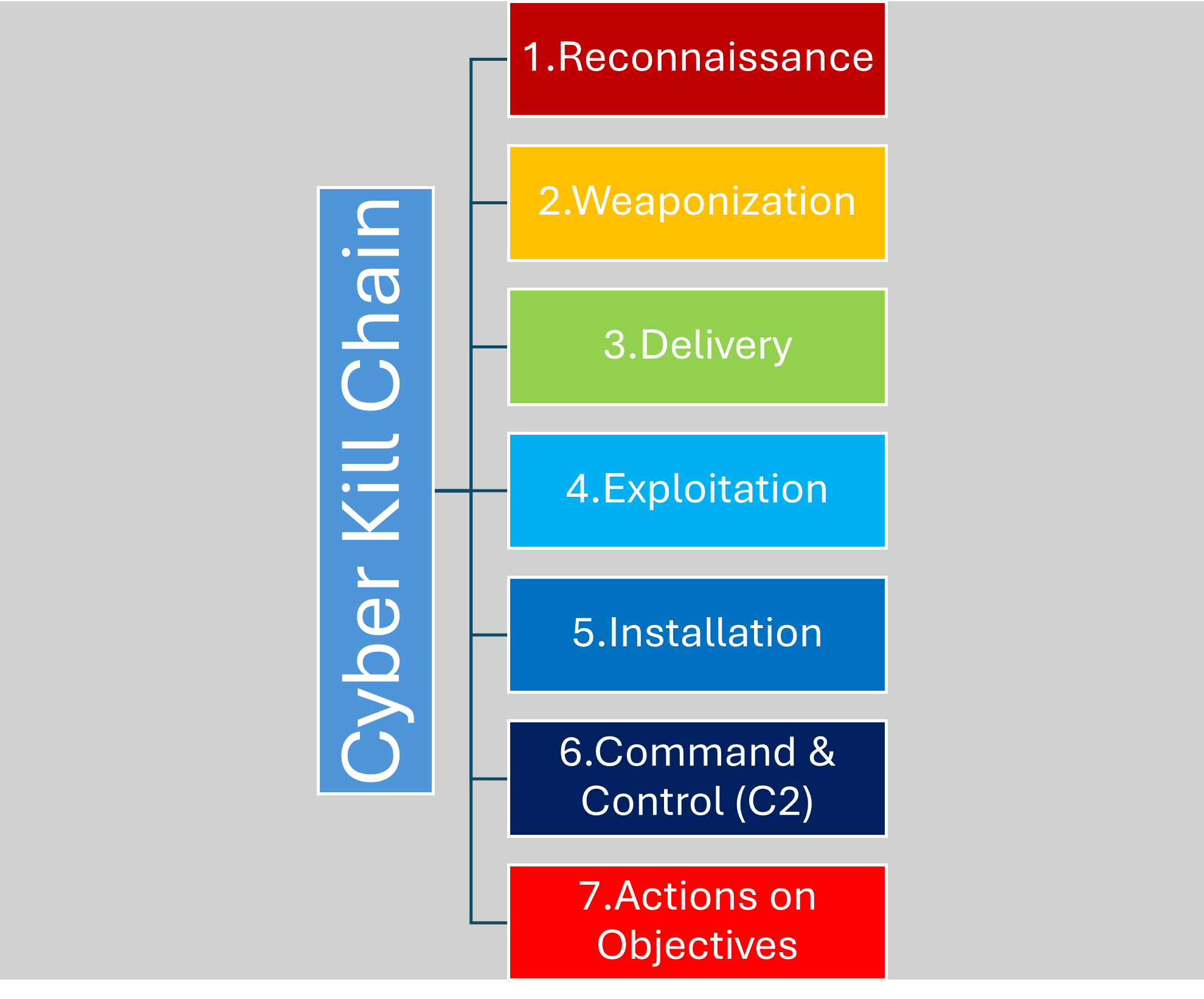Cyber Kill Chain Basics: Recognizing Hacker Tactics and Keeping Safe
 Harshal Shah
Harshal ShahTable of contents

In the ever-evolving world of cybersecurity, understanding how attackers operate is critical to building effective defenses. The cyber kill chain is a powerful framework that breaks down a cyberattack into distinct stages, allowing security professionals to identify and disrupt the attack at various points.
This blog will explore the cyber kill chain, providing real-world examples to illustrate each stage and offering insights on how you can fortify your defenses.
What is the Cyber Kill Chain?
The cyber kill chain, popularized by Lockheed Martin, is a metaphorical representation of the sequential steps attackers typically follow during a cyber intrusion. By understanding these phases, defenders can implement targeted security measures to disrupt the attack flow and minimize damage.

Here's a breakdown of the common stages in the cyber kill chain:
Reconnaissance: In this initial phase, attackers gather information about their target. This might involve scanning networks, identifying vulnerabilities in software, or even social engineering tactics like impersonating IT personnel to trick employees into revealing sensitive information.
Adversary: Gathers information through various methods (social media, web scraping).
Defender: Implements strong password policies, monitors external access attempts, limits publicly available information.
Real-World Example: Hackers targeting a hospital network might scan internet-facing systems to identify outdated software versions or misconfigurations.
Weaponization: Here, attackers develop or modify malicious tools to exploit the vulnerabilities discovered in the reconnaissance stage. This could involve crafting phishing emails with malicious attachments or weaponizing legitimate software with exploits.
Adversary: Develops exploits or chooses existing tools to target specific vulnerabilities.
Defender: Maintains updated systems with the latest security patches, conducts regular vulnerability assessments.
Real-World Example: An attacker might create a custom phishing email that appears to be from a legitimate source, containing a malicious attachment disguised as a tax document.
Delivery: Once the weapon is ready, attackers use various methods to deliver it to the target. This could be through phishing emails, malicious links embedded in social media posts, or even physically inserting infected USB drives into unsuspecting machines.
Adversary: Delivers malicious content through emails, social media, infected websites.
Defender: Educates users on phishing tactics, implements email security solutions, filters malicious URLs.
Real-World Example: Hackers might launch a spam campaign with phishing emails containing weaponized attachments.
Exploitation: If the delivery is successful and the victim interacts with the malicious payload (e.g., clicks a link, opens an attachment), the attacker attempts to exploit a vulnerability in the system to gain unauthorized access.
Adversary: Exploits vulnerabilities in software or operating systems to gain a foothold.
Defender: Uses endpoint detection and response (EDR) solutions, monitors system activity for anomalies.
Real-World Example: Clicking a malicious link in a phishing email might download malware that exploits a vulnerability in the user's web browser, allowing the attacker to remotely control the machine.
Installation: Once a foothold is established, attackers may install malware to maintain persistence within the system. This malware can steal data, launch further attacks within the network, or even disable security measures.
Adversary: Installs malware to maintain persistence and control over the system.
Defender: Implements application whitelisting, restricts unauthorized access to critical files and systems.
Real-World Example: Malware downloaded from a phishing email might install itself on the victim's computer, allowing the attacker to steal login credentials or launch ransomware attacks.
Command and Control (C2): After gaining access, attackers establish communication channels with the compromised system to issue commands, steal data, or maintain control over the infected device.
Adversary: Establishes communication with the compromised system to issue commands.
Defender: Monitors network traffic for suspicious communication patterns, blocks known C2 server addresses.
Real-World Example: Hackers might use a hidden server to communicate with compromised machines within a network, issuing commands to steal financial data or launch further attacks.
Actions on Objectives: This is the final stage where attackers achieve their ultimate goal, such as stealing sensitive data, deploying ransomware, disrupting critical systems, or launching espionage campaigns.
Adversary: Achieves their goals, such as stealing data, disrupting operations, or launching further attacks.
Defender: Implements data loss prevention (DLP) solutions, monitors for unauthorized access attempts, has incident response plans in place.
Real-World Example: After compromising a hospital network, attackers might steal patient records or launch ransomware attacks to extort money by encrypting critical healthcare data.
Defending Against the Kill Chain
Understanding the cyber kill chain empowers you to implement security measures at various stages to disrupt an attack. Here are some key takeaways:
Employee Training: Regular security awareness training can equip employees to identify and avoid phishing attempts and social engineering tactics.
Vulnerability Management: Regularly patching software vulnerabilities and keeping systems updated can significantly reduce the attack surface.
Endpoint Security: Implementing endpoint security solutions can detect and prevent malware installation on devices.
Network Security: Firewalls and intrusion detection/prevention systems (IDS/IPS) can monitor network traffic for suspicious activity and block malicious attempts.
Data Encryption: Encrypting sensitive data can make it unusable even if stolen by attackers.
Incident Response Plan: Having a well-defined incident response plan ensures a swift and coordinated response when a security breach occurs.
By understanding the cyber kill chain and implementing a layered security approach, you can significantly improve your organization's cybersecurity posture and make it a much harder target for attackers.
Subscribe to my newsletter
Read articles from Harshal Shah directly inside your inbox. Subscribe to the newsletter, and don't miss out.
Written by

Harshal Shah
Harshal Shah
Navigating the convergence of cybersecurity, DevOps, and cloud landscapes, I am a tech explorer on a mission. Armed with the prowess to secure digital frontiers, streamline operations through DevOps alchemy, and harness the power of the cloud, I thrive in the dynamic intersection of these domains. Join me on this journey of innovation and resilience as we sculpt a secure, efficient, and future-ready tech realm.